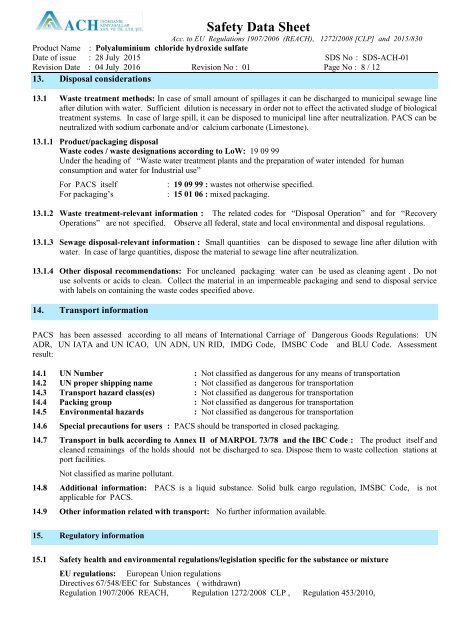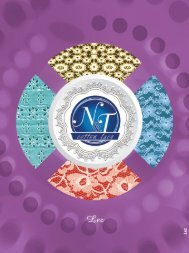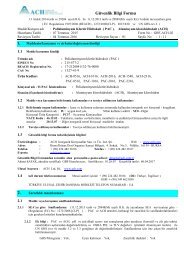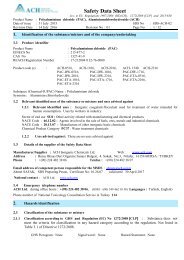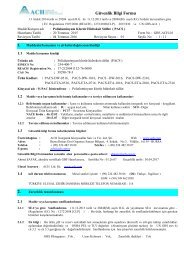PACS MSDS EN
Create successful ePaper yourself
Turn your PDF publications into a flip-book with our unique Google optimized e-Paper software.
Safety Data Sheet<br />
Acc. to EU Regulations 1907/2006 (REACH), 1272/2008 [CLP] and 2015/830<br />
: Polyaluminium chloride hydroxide sulfate<br />
Product Name<br />
Date of issue : 28 July 2015 SDS No : SDS-ACH-01<br />
Revision Date : 04 July 2016 Revision No : 01 Page No : 8 / 12<br />
13. Disposal considerations<br />
13.1 Waste treatment methods: In case of small amount of spillages it can be discharged to municipal sewage line<br />
after dilution with water. Sufficient dilution is necessary in order not to effect the activated sludge of biological<br />
treatment systems. In case of large spill, it can be disposed to municipal line after neutralization. <strong>PACS</strong> can be<br />
neutralized with sodium carbonate and/or calcium carbonate (Limestone).<br />
13.1.1 Product/packaging disposal<br />
Waste codes / waste designations according to LoW: 19 09 99<br />
Under the heading of “Waste water treatment plants and the preparation of water intended for human<br />
consumption and water for Industrial use”<br />
For <strong>PACS</strong> itself<br />
For packaging’s<br />
: 19 09 99 : wastes not otherwise specified.<br />
: 15 01 06 : mixed packaging.<br />
13.1.2 Waste treatment-relevant information : The related codes for “Disposal Operation” and for “Recovery<br />
Operations” are not specified. Observe all federal, state and local environmental and disposal regulations.<br />
13.1.3 Sewage disposal-relevant information : Small quantities can be disposed to sewage line after dilution with<br />
water. In case of large quantities, dispose the material to sewage line after neutralization.<br />
13.1.4 Other disposal recommendations: For uncleaned packaging water can be used as cleaning agent . Do not<br />
use solvents or acids to clean. Collect the material in an impermeable packaging and send to disposal service<br />
with labels on containing the waste codes specified above.<br />
14. Transport information<br />
<strong>PACS</strong> has been assessed according to all means of International Carriage of Dangerous Goods Regulations: UN<br />
ADR, UN IATA and UN ICAO, UN ADN, UN RID, IMDG Code, IMSBC Code and BLU Code. Assessment<br />
result:<br />
14.1 UN Number : Not classified as dangerous for any means of transportation<br />
14.2 UN proper shipping name : Not classified as dangerous for transportation<br />
14.3 Transport hazard class(es) : Not classified as dangerous for transportation<br />
14.4 Packing group : Not classified as dangerous for transportation<br />
14.5 Environmental hazards : Not classified as dangerous for transportation<br />
14.6 Special precautions for users : <strong>PACS</strong> should be transported in closed packaging.<br />
14.7 Transport in bulk according to Annex II of MARPOL 73/78 and the IBC Code : The product itself and<br />
cleaned remainings of the holds should not be discharged to sea. Dispose them to waste collection stations at<br />
port facilities.<br />
Not classified as marine pollutant.<br />
14.8 Additional information: <strong>PACS</strong> is a liquid substance. Solid bulk cargo regulation, IMSBC Code, is not<br />
applicable for <strong>PACS</strong>.<br />
14.9 Other information related with transport: No further information available.<br />
15. Regulatory information<br />
15.1 Safety health and environmental regulations/legislation specific for the substance or mixture<br />
EU regulations: European Union regulations<br />
Directives 67/548/EEC for Substances ( withdrawn)<br />
Regulation 1907/2006 REACH, Regulation 1272/2008 CLP , Regulation 453/2010,


